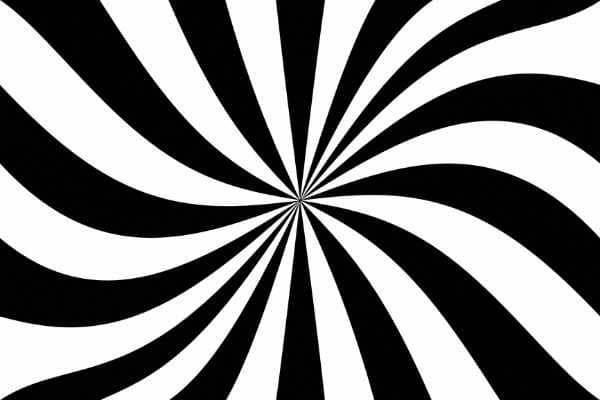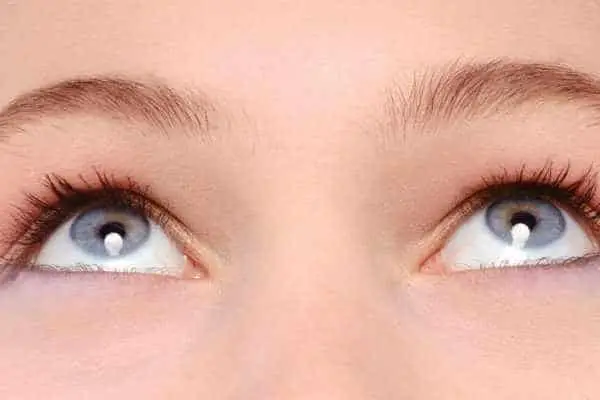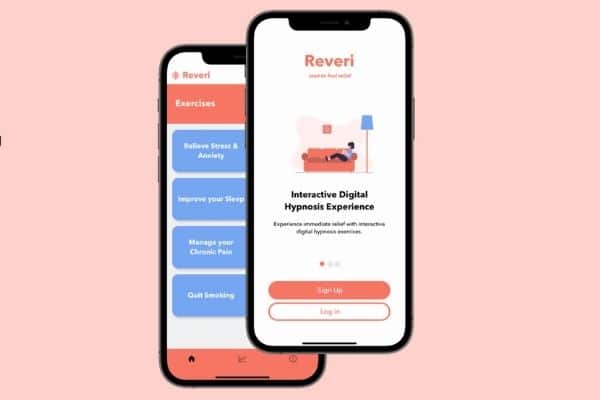Did you know you can use an app to hypnotise yourself? Or that self-hypnosis is a safe and powerful therapy?
I know it sounds crazy but it’s true, and highly recommended as a NSDR protocol option by Dr. Huberman. Dr. Spiegle, Stanford psychiatrist and hypnotherapy expert had designed an app so you can get the benefits of his scientifically tested treatments anywhere, anytime!
Huberman Hypnosis App
Ok, so I was pretty skeptical about self-hypnosis when Dr. Huberman mentioned hypnosis as a Non-Sleep Deep Rest protocol option.
Apparently he uses a self-hypnosis protocol regularly himself.
My knowledge of hypnosis was limited to stage hypnosis as a form of entertainment.
In the 1980s there was a stage hypnotist who toured his stage show at highschools. Brave souls would volunteer to go onstage and we would all be entertained as they were hypnotised into doing things like clucking like a chicken.

Even as a spectator I found the experience terrifying, horrified by the idea being embarrassed on stage.
So I only knew of stage hypnosis, and I only thought of hypnosis as a form of manipulation or mind control. And that is often how it is shown in popular culture.
This misundertanding of hypnosis is really unfortunate, as hypnotherapy is actually a reputable and very useful treatment technique.

And you do not lose control of yourself under hypnosis. I’ve learned that it is actually the complete opposite!
Reveri Hypnosis: State of Relaxation and High Focus
So let’s get down to basics.
What is hypnosis? Hypnosis is a unique mental state which combines high focus with relaxation.

What is so amazing about that?
Well, think about a situation in which you had really high focus. Were you relaxed? Probably not.

Normally a state of high focus is linked to excitement or caused by a high level of stress.
Hypnosis is powerful because the combination of high focus and relaxation that occurs at the same time in the hypnotic state accelerates therapy and learning.
But with hypnosis a state of intense focus and deep rest occur at the same time! So anything learned during hypnosis really stays in your mind!
Self-Hypnosis App: for Sleep, Anxiety & Learning
You can think about it is this way: Hypnosis is a tool that can be used many ways.
It can be used for entertainment in a travelling stage act, or hypnosis can be used for insomnia, as therapy, or even to increase learning.
And with Self-Hypnosis you remain in complete control.

The state of hypnosis brings about a state of focused attention, lack of self-consciousness, and greater control over one’s emotions and body sensations.
During hypnosis you will have:
- heightened awareness of the sensations in your body
- reduced distraction by anxious or intruding thoughts
- less rumination and mind wandering and your mind can feel less ‘crowded.’
And just like regularly practicing Yoga Nidra, regularly practicing self-hypnosis means you are learning skills you can use later when you need them.
This all sounds great to me, so I tried it.
Dr. David Spiegle Hypnosis App
There are many hypnotherapists who treat issues such as PTSD, anxiety and smoking. But what is you cannot find one nearby, or cannot afford one?

Imagine if you could get hypnotherapy from a trusted hypnotherapy expert….
well, you can with a free App!
Update – this app is no longer free except for a short trial period. It now has a yearly fee. It still is a very good and affordable resource if self-hypnosis does work for you.
The foremost expert on hypnotherapy is Dr. David Spiegle, the Medical Director of the Center for Integrative Medicine at Stanford School of Medicine.
Dr. Spiegle is no quack, he is a respected psychiatrist, with over 40 years of experience. He has studied hypnosis extensively and has created a Self-Hypnosis app Reveri.
Spiegel Eye Roll Test
Wondering how hypnotizable you are? There is a hypnotic test, called the Spiegel Eye-Roll test that you can try.
Dr. Huberman did the test on Tim Ferris while a guest on his podcast. He instructed Tim to look up, and then to slowly close his eyelids while still looking up.

It’s pretty funny to listen to. You can actually hear Dr. Huberman laugh and say ‘Oh boy, you’re really hypnotizable!“
He then explains that if you are not very hypnotizable, you have have a hard time closing your eyes slowly during the test. You’ll see their pupils as their eyes roll forward.
But if someone is easily hypnotizable they can close their eyelids very slowly and you can see the whites of their eyes during the test.
If they are very hypnotizable, their eyes will even start to roll back during the test.

This tests for whether you can do the first step needed for self-hypnosis, slowly closing your eyelids while looking up.
Dr. Huberman explained that looking up while closing our eyes involves a state of alertness with an action associated with sleepiness (our eyes closing).
Doing both at the same time creates a conflict in the nerves from the brain to the eye leading us into the special state of hypnosis: alertness with relaxation. (If you can do it.)
Reveri App: Learn Self-Hypnosis
So how does Dr. Huberman use hypnosis as an NSDR protocol? He uses the Reveri app.
The options for the Self Hypnosis Exercises are:
- Intro to Self Hypnosis
- Relieve Stress
- Improve Sleep
- Enhance Focus
- Eat Well
- Manage Pain
- Quit Smoking
In each 8-12 minute exercise you are guided into a self hypnotic state. The exercises are interactive, you will answer questions so the session proceeds in tune with your reactions.
You can also choose Reveri’s daily ‘Hypnotic Minute‘, which literally take a minute. Before doing these, I’drecommend you a the main exercise first to learn how to self-hypnotize yourself
In the ‘Relieve Stress & Anxiety’ Dr Spiegle guides into a self-hypnotic state and then to consider a problem you are facing.
He helps you to consider new strategies to reduce your anxiety and realize that your body can be comfortable despite the stress and uncertainty you feel.
You are guided to relax your body and helped through a problem solving exercise to help you face uncertainty.

Dr. Spiegle give you ways to deal with stress, including the suggestion to ‘make a plan that is good enough and cannot be perfect’.
Reveri App: Hypnotize Yourself
Don’t worry, you really do remain in control under Reveri guided self-hypnosis.
There is an introduction to each session that gives detailed information about how hypnosis works and how you can use it. You can skip the intro.
Each exercise starts with an explanation of the self-hypnosis exercise and what the goal of the exercise will be.
You are asked to rate how you feel prior to the exercise. Then you are asked to find a quiet space where you will not be disturbed.
To enter a pleasant state of self-hypnosis you are guided to
- Look up
- Slowly close your eyes and take a deep breath
- Let your breath out. Let your body relax and feel like you are floating.

You are guided to notice how you feel comfortable, and remember a time your body felt comfortable.
This initial step of the exercise teaches you how you can use memories and fantasies to help your body feel better. Then you are guided through the specific exercise that you chose.
When using the Reveri for self-hypnosis you should feel:
- heightened awareness of the sensations in your body
- reduced distraction by anxious or intruding thoughts
- less rumination and mind wandering and your mind can feel less ‘crowded.’
And this is absolutely what I experienced.
Reveri App: Best Self-Hypnosis App?
The Reveri App is pretty amazing really. At my own time, in my own home, I was guided into self-hypnosis by a world expert.
I admit, the whole Self-Hypnosis thing sounds pretty odd, and I felt silly using the app the first few times. But amazingly, it really seems to help.
It took me a few tries to be able to close my eyelids while looking up, but I figured it out. I guess I am not ‘easily hypnotizable’.
Once you have entered the state of Self-Hypnosis, Dr. Speigle tells you to let your hand ‘float up like a balloon’ and to feel ‘like you are floating’.

I definitely did feel the body lightness but wasn’t sure about the hand floating part.
Then in one session, while thinking ‘This is a little ridiculous!’ the strangest thing happened. My hand did just float up on its own.
‘Hmmm, Ok.’ I thought, ‘I guess this is working‘.
Reveri: Getting Back Out of Hypnosis
You do remain in control while using Reveri.
Once my husband came in the room while I was doing a Reveri exercise. He asked me a question, and I had no problem answering him appropriately. I just continued on with the Reveri exercise afterwards.
Getting out of Self-Hypnosis at the end the Reveri exercise:

At the end of the exercise you are guided out of the hypnotic state . You are asked to count backwards from 3 to 1 to get ready and then:
- Roll up your eyes, while keeping your eyes closed
- Let your eyes open slowly
- let your hand float down, make a fist and release it.
With the sleep exercise you do have the option to stay in the hypnotic state to fall asleep.
Reveri Hypnosis App for Anxiety
Just like regularly practicing Yoga Nidra, regularly practicing self-hypnosis with means you learn skills you can draw upon when needed.
So I kept it up, doing the Reveri ‘Relieve Stress’, ‘Improve Focus’ and ‘Improve Sleep’ sessions.
And then this interesting thing happened. I had a rather stressful situation, in which things were not going the way I had planned and I was getting pretty upset.

And, I actually heard Dr. Speigle’s voice and what he says in the ‘Relieve Stress and Anxiety,’ exercise: ‘Make a plan that is good enough’. And so, I accepted that I would need to figure it out a Plan B.
Which I did, and I was able to calm down.
Amazing.
NSDR Protocol: Meditation vs Hypnosis for Sleep
Self-Hypnosis with the Reveri app and Yoga Nidra Meditation are both recommended Non-Sleep Deep Rest protocol options, as discussed on ‘The Huberman Lab Podcast’, that are proven to recharge your brain.
Which to choose?

Dr. Huberman describes Self-Hypnosis this way:
And I’m a big believer in specifically self-hypnosis…which is a tool that you can access at any time.. any place… to create profound changes in your state of being.
You can specifically and consciously target habits you want to change, you can modulate pain in your body…there are so many ways to utilize this powerful tool that we discuss.
So Self-Hypnosis may be a better option is you are trying to make specific changes, such as improving your stress reactions or quitting smoking.
I was able to use the specific skills I gained from Reveri in a real life stressful situation.
One thing I noticed: You do need to interact with the Reveri app. You can answer the interactive questions on the screen but I found it best if I verbally answered the questions.
Which means if you are using headphones with someone nearby, it may be a bit awkward to enter self-hypnosis and interact with the app. With meditation this is not an issue.

I do have trouble calming my mind for sleep, I’ve use Reveri’s ‘Improve Sleep’ exercise for sleep and while it was good, personally I prefer to meditate lying down with Yoga Nidra at bedtime.
In the end, I think both Self-Hypnosis with the Reveri app and Yoga Nidra (my favourite Lizzi Hill session) are excellent tools. I enjoy both and use them in different ways.
Interested in more Huberman Lab information? Check out my post on Huberman Lab approved supplements for brain health.
Self Hypnosis References
- Brain Activity and Functional Connectivity Associated with Hypnosis
- Huberman Lab Podcast #8: OPTIMIZE YOUR LEARNING & CREATIVITY WITH SCIENCE-BASED TOOLS
- The Tim Ferriss Show: Dr. Andrew Huberman — A Neurobiologist on Optimizing Sleep, Performance, and Testosterone (#521)
- Replay of Learned Neural Firing Sequences during Rest in Human Motor Cortex
- Consolidation of human skill linked to waking hippocampo-neocortical replay
